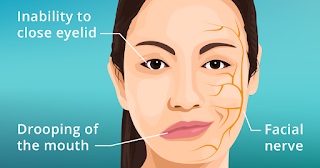Bell's Palsy and its Physiotherapy Intervention
Bell’s palsy is a condition that causes a temporary weakness or paralysis of the muscles in the face. It can occur when the nerve that controls your facial muscles becomes inflamed, swollen, or compressed. The condition causes one side of your face to droop or become stiff.
You may have difficulty smiling or closing your eye on the affected side. In most cases, Bell’s palsy is temporary and symptoms usually go away after a few weeks. Although Bell’s palsy can occur at any age, the condition is more common among people between ages 16 and 60
Symptoms:
The symptoms of Bell’s palsy can develop one to two weeks after you have a cold, ear infection, or eye infection. They usually appear abruptly, and you may notice them when you wake up in the morning or when you try to eat or drink.
Bell’s palsy is marked by a droopy appearance on one side of the face and the inability to open or close your eye on the affected side. In rare cases, Bell’s palsy may affect both sides of your face.
Other signs and symptoms of Bell’s palsy include: Drooling of saliva due to unable to close their mouth. Feeling difficulty while eating and drinking. Unable to so Some of facial expressions like smiling and frowning. Facial muscle weakness. Sometimes you can seen muscle switches in the face. Their face , mouth and eye will be try, May be having headache. They are having sensitivity to sound.
Causes:
Bell's palsy occurs when the seventh cranial nerve becomes swollen or compressed, resulting in facial weakness or paralysis.
The viruses that have been linked to the development of Bell’s palsy include:
Herpes simplex, which causes cold sores and genital herpes. HIV, which damages the immune system
- Sarcoidosis, which causes organ inflammation
- Herpes zoster virus, which causes chickenpox and shingles
- Epstein-Barr virus, which causes Mononeucleosis
Your risk of developing Bell’s palsy increases if you: are pregnant, have diabetes,have a lung function, have a family history
Medications:
- Corticosteroid drugs, which reduce inflammation
- Antiviral medication, such as Ipubrofen, which can help relieve mild pain
- using eye drops and an eye patch (for your dry eye)
- placing a warm, moist towel over your face to relieve pain
- Physiotherapy Management:
- Massage is very useful in Bell's Palsy . "Y'' shaped taping is very useful to prevent further weakness, and maintain the weakness. Electrical muscle stimulation. Some of useful home based activities are balloon blowing, making bubbles, blowing air out through the tight fist etc.
Exercises
Even though Bell’s palsy will disappear on its own in most cases, physical therapy can be used to speed up the process. The majority of these exercises are simply a matter of consciously recreating facial expressions. The good news is that these are simple, safe exercises that anyone can do unsupervised at any time of the day, making it easy to speed up the recovery process.
Sitting in front of a mirror, you should start off by moving all of the different parts of your face: forehead, eyebrows, nose/cheeks, and mouth. Try to raise both your eyebrows. You should expect that one side will raise noticeably higher and easier than the other, but don’t just keep trying to force the affected side to move. Gently use your fingers to help move your muscles in the right direction, trying to stimulate as much up and down movement as you can.
Next, you should scrunch up your face to stimulate movement in the nose and cheeks. You may be thinking that this region of the face does not require as much movement, but stiffness or weakness here can affect the whole face, so it is important not to neglect it. Once again, try to use your fingers to help the affected side of your face mimic the movement of the unaffected side.
You should also try inhale through the nose to flare up your nostrils. This is not likely to be an activity you attempt frequently, so if you’re having trouble, try various combinations of deep, slow, strong, and fast inhalations (just be sure to close your mouth for this exercise). You can also try covering the unaffected nostril, which may cause the affected nostril to work harder. It is important to note that at no point in these exercises should you have any difficulty breathing.
For the mouth, begin by trying to smile with your lips closed. Use your fingers to make sure that the two corners of your mouth stay in the same relative position on your face. After doing this a few times, take your fingers away and try to hold your smile in position unaided for as long as you can. Then repeat this exercise, only by lifting each corner of your mouth individually.
For the affected eye, you should look down, close the eye, and use your fingers to stretch the eyebrow above it, while also lightly rubbing the eyelid. The goal of this exercise is to prevent the eyelid from becoming stiff. After this, see how much movement you have in the eyelid. If you have trouble closing it, squinting may also help.
The eye can be one of the most demanding aspects of Bell’s palsy. If you are having trouble closing one eye, this could lead to irritation and other problems. Eye drops are recommended to anyone who has difficulty in this area, and many patients find that wearing an eyepatch to bed makes their situation more manageable.

Worthy...
ReplyDelete